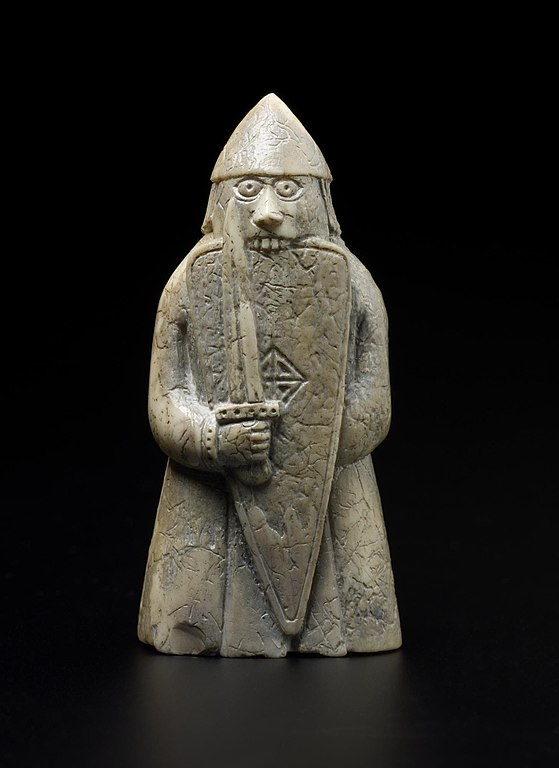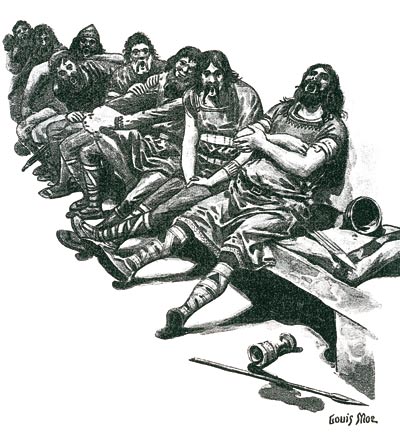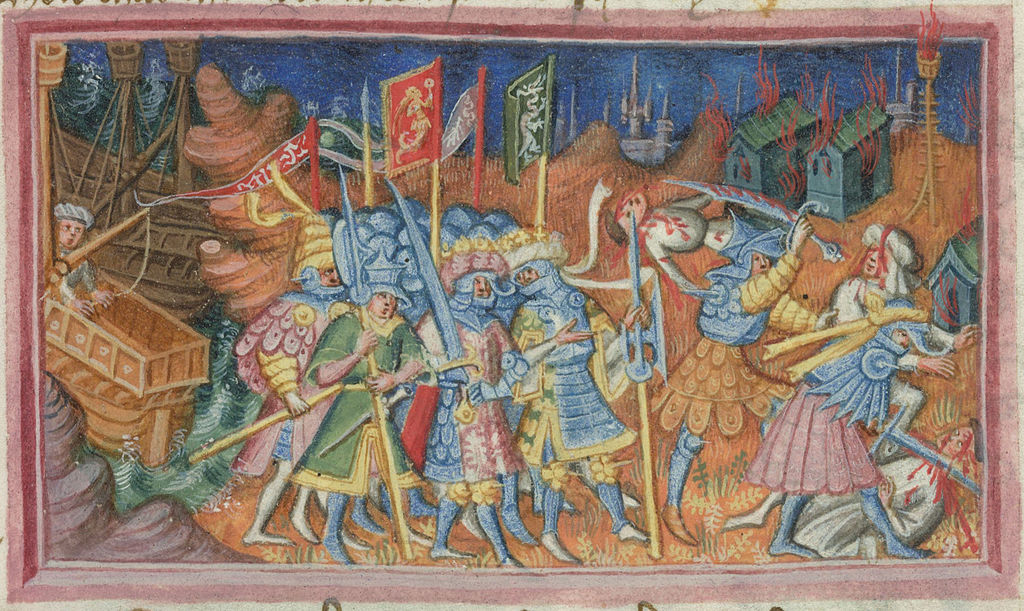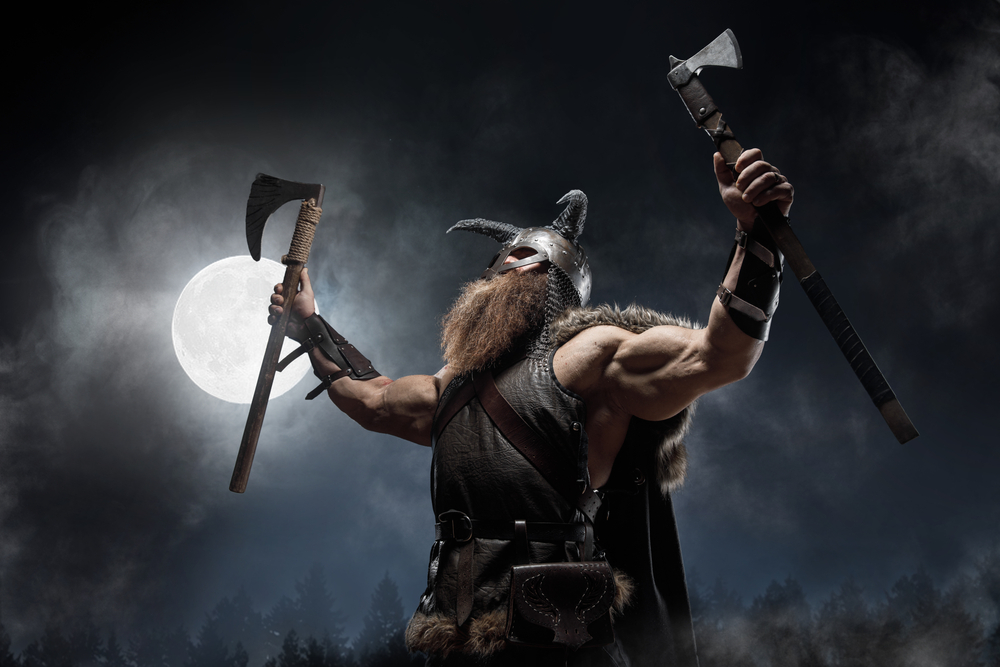Berserkir were fierce Viking warriors who fought or only dressed in the skins of bears and wolves. The heightened state of violence could have been down to the influence of mind-altering drugs (according to a 17th century scholar).
Viking berserkers fought as mercenary bands for hundreds of years during the Viking Ages, traveling wherever they could find paid work.
They also worshiped the god Odin and had associations with mythological shapeshifters.
What is a Norse Berserker?
In battle, berserkers went into a kind of trance and howled like animals, foamed at the mouth, and bit their shields. They believed themselves immortal and impervious to injury from swords or spears. However, when the rage subsided, they were weak and docile.
The word “berserker” derives from the Old Norse word for “shirt” (serkr) and the word for “bear” (ber), suggesting that berserkir could have worn bearskins and wolfskins to battle. It is also possible that the “ber-“ in berserkir means “naked”.
There are also reports that rather than wearing the skins, berserkers could actually shapeshift into bears and wolves.
Medieval age accounts of berserkir portrayed them as elite warriors and champions, but their reputation worsened as time passed. They became noted for their bragging rather than noble or heroic deeds and, later, for pillaging and looting.
Jarl Eiríkr Hákonarson of Norway (in 1015) and Grágás, the medieval Icelandic law code eventually made it illegal to be a berserkir.
The Torslunda Plates Illustrations of Berserkers
The Torslunda Plates, discovered on the island of Öland (Sweden) and dating back to the sixth century, show illustrations of how berserkir might have dressed in battle.
Priscilla K. Kershaw, author of The One-eyed God: Odin and the (Indo-) Germanic Männerbünde, describes a helm-plate press depicting a one-eyed Odin in a horned helmet adorned with a bird. She says the figure next to Odin is a berserker wearing a wolf pelt and holding a spear.
![The Truth About Norse Berserkers 2 One of the Vendel era Torslunda plates found on Öland, Sweden. It probably depicts one-eyed Odin guiding a Berserker.[1]](https://norsemythologist.com/wp-content/uploads/2022/11/Bronsplåt_2_fr_Torslunda_sn_Öland_Stjerna_Hjälmar_och_svärd_i_Beovulf_1903_sid_103.jpg)
The Lewis Chessmen and the Representation of a Berserker
The Lewis chessmen excavated in the Outer Hebrides (Scotland) on the Isle of Lewis, but thought to be of Norwegian origin, show berserkers biting their shields.

What Are Some of the Traits of a Norse Berserker?
A berserker had to be able to enter a hypnotic state of blind fury which allowed them to fight without fear or hesitation.
In the Ynglinga Saga, the 13th-century Icelandic historian and poet Snorri Sturluson described the berserkers in Odin’s armies as “mad as dogs or wolves,” “strong as bears or wild oxen,” and able to kill people with a single swing of their sword. He added, “neither fire nor iron told upon them.”
The state of blind fury was called “berserkirgang.” It is a more extreme version of the sensations caused by the “red mist.” This expression is used to describe a feeling of rage that clouds a person’s judgment and makes them behave in a way that is not characteristic of them.
Berserkers could reportedly shapeshift mainly into bear-like creatures, although wolves and wild boars are also mentioned.
Sturluson repeats that “neither fire nor iron told upon them” and that edged weapons and fire did not harm the berserkers several times. However, they were vulnerable to blunt instruments, like hammers and clubs.
Berserkers can supposedly blunt enemy blades with spells or by simply looking at them – something Grendel does when he appears in the tales of Beowulf.
Some berserkers wore animal skins of wolves, bears, or wild boars as totems.
Ulfheðnar – The Wolf Warriors Vs. Berserkers
Frenzied warriors wearing wolfskins over chain mail called ulfheðnar (literally: “wolf coat”) appear in the sagas of Vatnsdæla and Grettis as wild shock troops following the Norwegian king, Harald Fairhair.
There were two types of “warrior-shaman”: berserkers and ulfheðnar. Ulfheðnar Norse warriors were not berserkers, and references to them are scarce.
Egil’s Saga featured Kveldulf (or Eve-Wolf), a man who changed into a wolf at night. However, the Saga described him as a berserker, not an ulfheðinn (the singular form of ulfheðnar).
In Hilda R.E. Davidson’s 1978 novel, Shape Changing in Old Norse Sagas, she described the ulfheðnar as elite warriors of Odin. She wrote that Odin’s men: “went without their mail coats, were mad as hounds or wolves, and bit their shields.” and “they slew men, but neither fire nor iron had any effect upon them.”
These sagas named four distinct types of berserkers:
- The Viking berserkr;
- the “hall-challenger” berserkr;
- The king’s berserkr and;
- the hólmgangumaðr
Bear powers
Some authors believe that berserkers obtained their powers from bears and were part of a bear-worshiping cult.
Mary Danielli wrote in her book Initiation Ceremonial from Norse Literature that berserkers placed their dead on bearskins before their funeral ceremonies. The Danish royal guard still wears bearskin hats.
Bödvar Bjarki appears in the Saga of Hrólf Kraki. He shapeshifts into a bear while fighting for king Hrólfr Kraki: “Men saw that a great bear went before King Hrolf’s men, always keeping near the king. He slew more men with his forepaws than any five of the king’s champions.”
Egil’s Saga also mentions berserkers. It describes the men who visit King Harald after the murder of his brother Thorolf as “the hardest of men, with a touch of the uncanny about a number of them” and “built and shaped more like trolls than human beings.”
Berserkers and Wild Boar Symbolism
Swine in Norse mythology and religion were connected to seiðr, the magic practiced by Freyja and other völvas in Vanaheim.
Boars were symbols of fertility and strength and often appeared on helmets as warriors believed the characters offered extra protection.
Are Vikings and Berserkers the Same?
Ordinary Viking warriors were fearsome enough, but Viking berserkers took aggression and fighting frenzy to a different level.
Reputed to howl, roar, and grunt like wild animals during battle and ignoring pain and fear, they were a formidable opponent.
The Varangian Guard, a Byzantine army of the 10th century, initially comprised warriors from Scandinavia. They used their powers of berserker rage to defend their ruler.

How Did a Viking Become a Berserker?
Rumors abound of Vikings taking hallucinogenic drugs. However, it is likely that certain rituals, such as shield-biting and chanting, conducted in the hours before battle sent the fighters into a trance-like state of controlled fury (“berserkergang”). This state allowed them to ignore pain and fear.
Mental illness has also been suggested as a likely reason for the ability to become a berserker.
Previously, some scholars have suggested that consuming potentially hallucinogenic mushrooms (Amanita muscaria) or fly agaric could induce a trance-like, berserker state. Ergot poisoning (consumption of fungus-infected grain) has also been suggested as the cause.
However, Karsten Fatur wrote in an article appearing in The Journal of Ethnopharmacology that henbane is a more likely reason if hallucinogens were involved at all.
*Make sure to also check my article on Viking drengr.
Were There Any Female Berserkers?
Peter Pentz, the curator of Danish Prehistory at the National Museum of Denmark, claims that there are references to women in tales of berserkers.
“The term ‘berserkir brides’ appears in medieval texts,” he said. “What it covers is uncertain, but some say female berserkir, others say giantesses.”
What Kind of Weapons Did Norse Berserkers Use?
In Haraldskvæði, the skaldic poem about Harald Finehair, his berserkers “bear bloody shields and red with blood are their spears when they come to fight.”
Pentz believes they would carry typical Viking weapons, like swords, axes, and spears.
Who Are the Most Famous Berserkers in Norse Sagas?
The first berserker is often said to be Hardbeen. In the Ynglinga Saga, he was immune to damage from edged weapons, so his enemy Halfdan killed him with a blow from his hammer.
Bödvar Bjarki was a hero from the 15th-century Saga of Hrólf Kraki. Bödvar was a shapeshifter who could take the form of a bear.
Ivar the Boneless was a champion berserker who fought in a blind, trance-like fury. He and his brothers invaded numerous Anglo-Saxon kingdoms.

Egil Skallagrimson, the “Egil” from Egil’s Saga, is a berserker, as is his father Skallagrim (“bold mask”) and his grandfather Kveldulv (“night wolf”).

